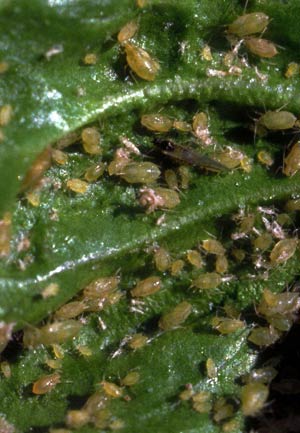|
The focus of this study was to demonstrate IPM at a commercial scale with lettuce aphid, Nasonovia ribis-nigri present, rather than replicated small-plot experiments.
The trial was at Forthside Research and Demonstration Farm near Devonport, Tasmania. Lettuce had not been grown on Forthside farm for many years but lettuce aphid is well established in the district.
A series of four field days designed for small groups of growers to monitor crop progress and observe decision-making were the core of the project. Two additional open days made the project familiar to a broader audience including interstate visitors.
Additional measures of marketability of undrenched aphid-susceptible IPM lettuce were obtained by selling 550 dozen in vegetable shops. The state buyers for Woolworths and Coles also assessed several cartons of undrenched susceptible IPM lettuce. Neither the marketplace nor the supermarket buyers rejected the lettuce although none have yet been marketed in the two major supermarket chains.
Other pests present in this trial were Rutherglen bug, green leafhoppers, brown leafhoppers, potato bug, Thrips sp. (not WFT) and slugs.
The major beneficial insects seemed to be brown lacewing, 11-spotted ladybird, transverse ladybird, Melangyna hoverflies, damsel bugs, many spider species, many microwasp parasites, predatory mites and predatory Aeolothrips thrips.
Authors
|
Paul Horne
|
Jessica Page
|
Lionel Hill
|
Sandra McDougall |


Findings :
-
IPM is a viable alternative to seedling drenches for managing Tasmanian lettuce pests including the new pest, currant lettuce aphid. Plantings 1 to 7 produced marketable undrenched susceptible lettuce and many were sold. Foliar insecticides are not even an alternative – they helped lettuce aphid populations to grow.
-
IPM cannot be used alongside large areas of drenched lettuce. Attempts to try IPM in a piecemeal fashion will fail as will attempts to try it at the end of a season of drenching or spraying. The overall sequence of plantings and the areas that can support populations of beneficial species are critical in an IPM strategy to control lettuce aphid.
-
Confidor, Actara and Chess seedling drenches, including a low rate of Confidor, were associated with the highest Heliothis caterpillar populations and did not reduce cutworm problems.
-
Broad spectrum insecticides such as Dominex cause aphid problems. They are now used in efficacy trials to build lettuce aphid populations so that other chemicals can be tested.
-
The supposedly selective aphicide, Pirimor, needs to be investigated more closely. In Plantings 1 and 2 in this trial it temporarily disrupted or delayed natural control of aphids.
-
One fungicide, mancozeb, appeared to suppress the ladybird population in early plantings.
-
Some aphids are invisible! Growers, supermarket buyers and consumers repeatedly scored lettuce as clean and fit for market when detailed dissection revealed a handful of aphids or other tiny insects per lettuce.
-
The research team expects massively increased problems with Western Flower Thrips on the mainland where Confidor is used because of its effects on predators.
-
We grew several crops of lettuce with no fungicide and one application of a BT spray or Success and marketed ‘clean’ lettuce again and again through spring and summer and into early autumn. Perhaps we would have had less success if we used a site with a history of lettuce diseases and poorer air-flow and hence more fungicides. Perhaps we would have less success if we had used more foliar insecticides for Rutherglen bug and leafhopper incursions.
-
The trial successfully demonstrated that there was a commercially viable and scientifically sound alternative (IPM) to drenching with high rates of Confidor to control lettuce aphid.
Acknowledgments :
This project was facilitated by HAL in partnership with AUSVEG and was funded by the National Vegetable levy. The Australian Government provides matched funding for all HAL’s R&D activities.
|

